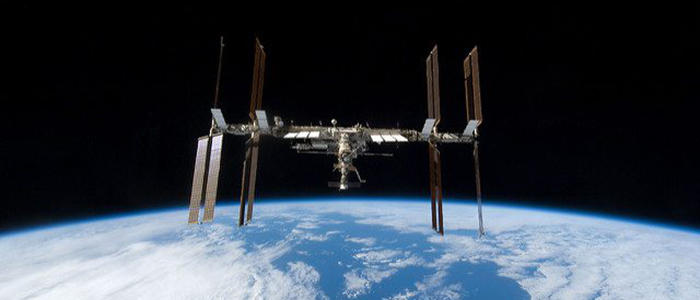Studying microbes in space
Posted on March 24, 2017 by Anand Jagatia
A new microbe has been discovered on the International Space Station. The species, Solibacillus kalamii, was isolated from an air filter on board the station, and is described in the Microbiology Society’s journal, IJSEM.
In space, no one can hear you clean.
Okay, strictly speaking that isn’t true. But cleaning in space isn’t something that you tend to hear much about, even though keeping the International Space Station (ISS) spic and span is a top priority for the astronauts who call it home.

NASA’s Marshall Space Flight Centre on Flickr under CC BY-NC-ND 2.0
This is because the ISS is a closed system, meaning the air inside has to be continually recycled. To make sure it stays clean and fresh, the environmental control systems are packed with air filters to get rid of dust and germs. The astronauts also have to do their bittoo – tidying, cleaning and vacuuming is a regular part of life aboard the space station.
All of this rubbish has to go somewhere, and normally the space station just jettisons all its trash in a giant capsule that burns up in the Earth’s atmosphere. But to researchers, the dust inside the air filters and vacuum cleaner bags is too valuable to just throw away. Instead it makes its way back to Earth, where it ends up in the hands of Dr Kasthuri Venkateswaran – a microbiologist working at NASA’s Jet Propulsion Lab.
Part of Venkat’s job is to monitor the microbes on the space station, to see if any of them could pose a threat to the astronauts on board. But it’s also to search for microbial species we’ve never seen before, in the hope that they may have useful characteristics.
The group has been busy analysing a 40-month-old HEPA filter from the ISS that was brought back to Earth on the Space Shuttle Endeavour. HEPA stands for High Efficiency Particulate Arrester, and these filters are able to trap anything larger than 0.3 microns (0.0003 mm) across, and according to Venkat, can collect 99.97% of microbes passing through them. Having travelled to space and back, these filters have to be handled carefully, to prevent any contamination from terrestrial microbes.
“We have a clean room to open such precious samples,” says Venkat. “So I opened it here, we collected the debris from the filter paper, and then carried out a microbial analysis.”
When they looked at the microbes that are orbiting the Earth with the astronauts, the team found a new species: Solibacillus kalamii. They describe their find in the Society’s International Journal of Systematic and Evolutionary Microbiology. This new species looks well adapted to living in the difficult conditions 250 km above us.
“Solibacillus kalamii actually possesses an extraneous layer [on its outer surface],” explains Venkat. “Certain microbes have an extra layer rich in lipoglycoprotein, a kind of blanket. This can be used as a protective agent against radiation, like sun screen.”
Venkat hopes that biocompounds like these could one day be incorporated into space suits, and provide extra protection for astronauts when they are outside the space station. The ISS is a great location to look for compounds like this, as only hardy microbes which adapt to these tough conditions can survive.
“High radiation, microgravity, high CO2 – these are conditions that make some microbes perish, but other [tolerant] microbes that develop adaptive strategies can survive.”
This work was part of a project called MT-1 (Microbial Tracking 1), looking at the surfaces and air supply in the space station for three consecutive flights. But Venkat’s team is also working on other projects.
One of these is called Micro-10, where the group sent the fungus Aspergillus nidulans up to the ISS and compared it to one that was grown here on Earth. The aim is to explore whether microgravity allows microbes to produce novel compounds that could be used as drugs or within biotechnology.
Another is a project called MT-2, which is looking specifically for pathogens on board the space station, to understand how microbes may influence astronaut health.
“In a closed system, the astronauts are constantly shedding microbes and picking them up – it’s like living in an intensive care unit,” says Venkat.
This kind of microbiological research is especially important for looking at the effects of long-haul space flight. If we ever do make it to Mars, the trip would take 6–8 months – it would be a wasted journey if the astronauts got sick before they arrived.
